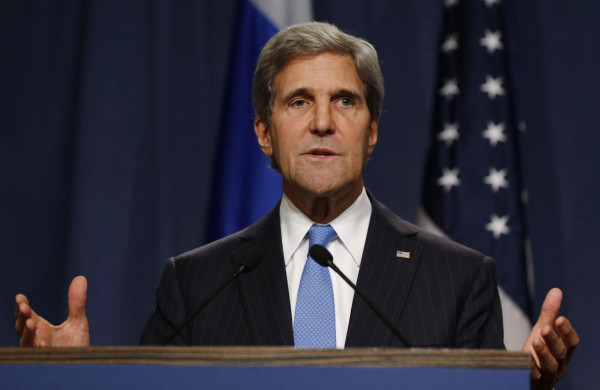by Paul Pillar*
Now that Secretary of State Kerry’s attempt to breathe life into the diplomacy known as the Middle East peace process has been widely pronounced—even by those who appropriately salute his efforts—to be a failure, different quarters are chiming in with recommendations for what to do next about the Israeli-Palestinian conflict. Some suggestions are helpful; others would only help to perpetuate the Israeli occupation and lack of an agreement, and may be tacitly intended to do just that.
The New York Times editorial board proposes that the United States, as a last act before ending this phase of its active diplomacy on the problem, post on the international bulletin board its own sense of what the principles of a final settlement ought to look like. This is probably worth doing, and it has the merit of reflecting the fact that the basic lines of a feasible two-state solution have been apparent for some time. Perhaps this would help to clarify who is resisting such a settlement and who is not. This has been tried before, however, most notably with the Clinton parameters, and it was insufficient to push the process over a finish line.
A couple of other limitations and uncertainties, revealed in the most recent diplomacy, would have to be overcome for such a U.S. declaration of principles to help. One concerns whether the Obama administration would be able and willing to backtrack on how, in its recent efforts to get some kind of preliminary agreement, it moved away from the consensus feasible settlement and adopted certain Israeli positions, such as regarding a continued troop presence in the Jordan River valley, that were bound to be unacceptable to any Palestinian leader. The other uncertainty concerns the ability of one of the parties—with the Israeli government demonstrating this skill in virtuoso form—to use mixtures of procedural and substantive issues to put off any agreement even without explicitly rejecting U.S.-promulgated principles. The Netanyahu government has done this with its “Jewish state” demand and, more recently, with its reneging on a commitment to release Palestinian prisoners. The latter tactic resembles the familiar North Korean ploy of selling the same horse twice by making new demands for compensation in return for doing something it was already supposed to do anyway.
A different, but old and familiar, proposal that comes from those most sympathetic to an indefinite Israeli occupation has been voiced anew by Jackson Diehl of the Washington Post and Michael Singh of the Washington Institute for New East Policy. This notion is that a Palestinian state is not something to be created from above through negotiations but built up from below through a long process of developing Palestinian institutions. The idea is that statehood is not a gift to be given to the Palestinians, but something they must earn by being good administrators. The appropriate role for the United States and other outsiders, according to this formulation, is to provide assistance and tutelage in being good administrators. Thus Diehl says, “The Obama administration could have kept the forward movement going by continuing to promote the construction of Palestinian institutions — including a democratic, corruption-resistant government — and by pushing Israel to turn over more security responsibility and remove impediments to the Palestinian economy.” Similarly, Singh writes that “a greater emphasis should be placed on Palestinian economic growth and reform” and addressing “corruption in the PA.”
This idea is not a prescription at all for reaching a settlement, ending the occupation, and creating a Palestinian state. It instead is a prescription for extending the occupation indefinitely by making it run smoothly. It is a method for making the principal Israeli sub-contractor for the occupation—because that is what the Palestinian Authority has become—do its part of the occupation duties tolerably well. Meanwhile, Israel arrogates for itself the function of judge in determining whether the Palestinians have performed well enough to move to the next stage of this game. There will always be some reason why they are declared not yet ready. Corruption, as mentioned by both Diehl and Singh, will be a perennial favorite issue for this purpose. If necessary, the Israelis can take direct action to make sure the economic and security performance of the Palestinians does not get too good, lest too many people start asking whether they really are ready for a state. The Israelis have done so in the past by trashing Palestinian infrastructure in the West Bank, and of course have done so in a more brutal way with the Gaza Strip in making it as difficult as possible for the Palestinian governing authority there to govern.
Singh states, “The Israeli-Palestinian conflict is not ripe to be solved.” The obvious, glaring question to be asked in response is, “So when, after 47 years of occupation and more than two decades since the Palestinian Authority was created, will it ever be ripe?” The actual answer, of course, given the framework Singh is trying to impose, is “never.” But the false promise of statehood at the end of the rainbow helps to keep enough Palestinians docilely on the reservation while the occupation continues.
Diehl tries to encourage the idea that there actually is some sort of progression toward that ever-receding statehood pot at the rainbow’s end by asserting that there has been “cumulatively enormous progress toward coexistence” and the parties “have traveled most of the path to a final settlement.” Totally ignoring trends in Israeli politics over the last twenty years, he would have us (and Palestinians) believe that the Palestinians are closer to having a state now, in the era of Benjamin Netanyahu, than they were when Israeli policy was made by Yitzhak Rabin. Amazingly, Diehl cites as progress Ariel Sharon’s pull-out from the Gaza Strip, as if a unilateral action leading to a suffocating blockade and destructive military assaults is somehow a step toward a negotiated settlement providing for two states living peacefully beside each other. He also strains to reassure us about the continued construction of Israeli settlements, saying that the pace of colonization has slowed from earlier in the occupation and that most of the new housing is in “areas near the 1967 border,” apparently paying no attention to recent land appropriations that Haaretz describes as the “largest in years.”
Amid the fact-creating on the ground and the false-promise-making in print, it is understandable that more and more people talk of discarding hope for a two-solution and concentrating on trying to obtain human rights within one state. Even the son of Palestinian Authority president Mahmoud Abbas has made this transition. But no one has yet sufficiently explained how the nationalist aspirations of both Israeli Jews and Palestinian Arabs could be satisfied this way, and if they cannot, how a one-state solution would endure.
Perhaps action needs to be taken in the name of human rights within a single state, but without discarding the goal of two states. In this regard one of the best suggestions for where things ought to go from here comes from Henry Siegman:
A two-state outcome is still possible if Palestinians were to take their fate into their own hands, rather than waiting for a deus ex machina, by shutting down institutions such as the Palestinian Authority that serve their subjugators and launching a non-violent, anti-apartheid struggle for equal citizenship in the de facto Greater Israel to which they have been consigned. Such a determined struggle may even convince Israelis to accept a two-state outcome, for the loss of their state’s Jewish identity in a single state in which Jews are outnumbered by Arabs is a price most Israelis will not pay for a Greater Israel.
Siegman assesses that if Israel still rejected a two-state solution under such conditions, broad international backing for the anti-apartheid struggle would lead even Washington to abandon Israeli apartheid. That is hardly a given, and American policy in such circumstances would still be the most critical variable of all.
*This article was first published by the National Interest and was reprinted here with permission.






George W. Bush should have had the sense to endorse the 2002 Saudi Peace Plan. This plan still offers a fair deal to both sides (with a few tweaks).
Obvious that there is no solution within grasping distance under the present circumstances. The best and probably only avenue to take, is for the U.S. to abandon Israeli symbiosis, quit blocking the Palestinians in the U.N.S.C., let the Palestinians apply and achieve the ICC that Israel fears, and most of all, renounce apartheid. Of course, there will be wailing & who be mes from the AIPAC & recipients of their money, but it’s time to end this one way dog and pony show. Oh, as an added incentive for Israeli action to join the rest of the world democracies, the U.S. can sign a pact with Iran to protect it from being attacked by Israel. Now, any or all of these things will either get a settlement, or put a stop, if “cold turkey” might be used.
What to do now?
(Obama & Kerry) Try reading your Bibles! God gave Israel to the Jews!!!
Trust me. You don’t want to mess with God.
Precisely, Mr. Canning. Turn the Saudi Plan into a joint Arab/American Plan. It has not been acceptable to the Israelis because it IS a fair deal given present circumstances. It should be openly endorsed as American policy. And it could easily become formal European policy and UN policy too. We would then have a benchmark, a concrete, more or less take it or leave it offer which would eliminate the potential for deal killing nonsense in negotiations from the Israelis.
The key to it is political pressure from all points of the compass. It was far sighted when the Israelis and the Lobby implanted within us the idea that no matter what, pressure could not ever be applied to Israel. That is nonsense. When we bought that idea we gave up having any influence over a foreign policy matter of grave importance to us. It’s grossly humiliating. We need simply put and end to it. Apply the pressure in doses until they come to us rather than vice versa.
Thanks, Hunter. You outline a simple and fair way forward.